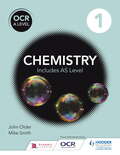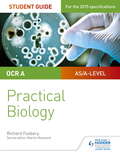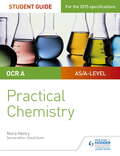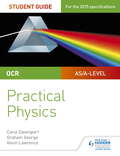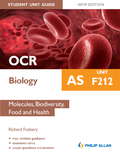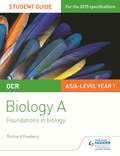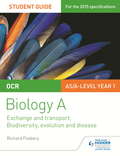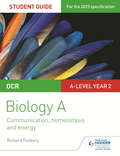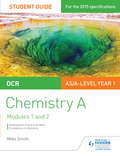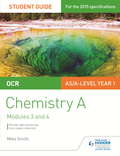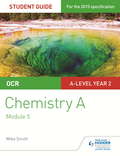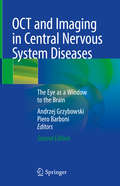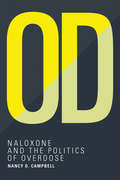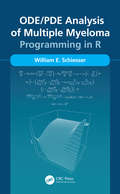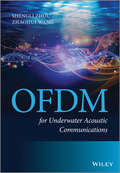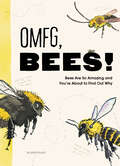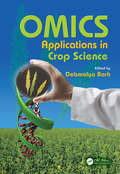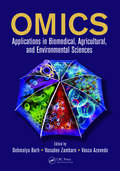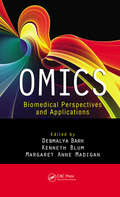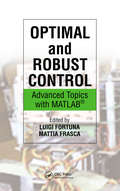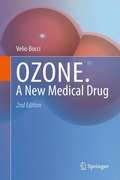- Table View
- List View
OCR A level Chemistry Student Book 1
by Mike Smith John OlderExam Board: OCRLevel: A-levelSubject: ChemistryFirst Teaching: September 2015First Exam: June 2016This is an OCR endorsed resourceStretch and challenge your students' knowledge and understanding of Chemistry, build their mathematical and practical skills, and provide plenty of assessment guidance with this OCR Year 1 Student Book. - Build understanding with a summary of prior knowledge and diagnostic questions at the start of each chapter to help bring students up to speed- Support practical assessment with Practical Skill summaries that help develop your students' knowledge and skills- Test understanding and provide plenty of practice to assess progression, with Test Yourself Questions and multiple choice questions- Provide mathematical support with examples of method integrated throughout and a dedicated 'Maths in Chemistry' chapter- Develop understanding with free online access to Test yourself Answers, an Extended Glossary, Learning Outcomes and Topic SummariesOCR A Level Chemistry Student Book 1 includes AS Level
OCR A-level Biology Student Guide: Practical Biology
by Richard FosberyEnsure your students get to grips with the core practicals and develop the skills needed to succeed with an in-depth assessment-driven approach that builds and reinforces understanding; clear summaries of practical work with sample questions and answers help to improve exam technique in order to achieve higher grades.Written by experienced teacher Martin Rowland, this Student Guide for practical Biology:- Help students easily identify what they need to know with a concise summary of required practical work examined in the A-level specifications.- Consolidate understanding of practical work, methodology, mathematical and other skills out of the laboratory with exam tips and knowledge check questions, with answers in the back of the book.- Provide plenty of opportunities for students to improve exam technique with sample answers, examiners tips and exam-style questions. - Offer support beyond the Student books with coverage of methodologies and generic practical skills not focused on in the textbooks.
OCR A-level Biology Student Guide: Practical Biology
by Richard FosberyExam Board: OCR Level: AS/A-level Subject: Economics First Teaching: September 2015 First Exam: Summer 2016Ensure your students get to grips with the core practicals and develop the skills needed to succeed with an in-depth assessment-driven approach that builds and reinforces understanding; clear summaries of practical work with sample questions and answers help to improve exam technique in order to achieve higher grades.Written by experienced teacher Martin Rowland, this Student Guide for practical Biology:- Help students easily identify what they need to know with a concise summary of required practical work examined in the A-level specifications.- Consolidate understanding of practical work, methodology, mathematical and other skills out of the laboratory with exam tips and knowledge check questions, with answers in the back of the book.- Provide plenty of opportunities for students to improve exam technique with sample answers, examiners tips and exam-style questions. - Offer support beyond the Student books with coverage of methodologies and generic practical skills not focused on in the textbooks.
OCR A-level Chemistry Student Guide: Practical Chemistry
by Nora HenryEnsure your students get to grips with the core practicals and develop the skills needed to succeed with an in-depth assessment-driven approach that builds and reinforces understanding; clear summaries of practical work with sample questions and answers help to improve exam technique in order to achieve higher grades.Written by experienced teacher Nora Henry, this Student Guide for practical Chemistry:- Help students easily identify what they need to know with a concise summary of required practical work examined in the A-level specifications.- Consolidate understanding of practical work, methodology, mathematical and other skills out of the laboratory with exam tips and knowledge check questions, with answers in the back of the book.- Provide plenty of opportunities for students to improve exam technique with sample answers, examiners tips and exam-style questions. - Offer support beyond the Student books with coverage of methodologies and generic practical skills not focused on in the textbooks.
OCR A-level Chemistry Student Guide: Practical Chemistry
by Nora HenryExam Board: OCR Level: AS/A-level Subject: Chemistry First Teaching: September 2015 First Exam: Summer 2016Ensure your students get to grips with the core practicals and develop the skills needed to succeed with an in-depth assessment-driven approach that builds and reinforces understanding; clear summaries of practical work with sample questions and answers help to improve exam technique in order to achieve higher grades.Written by experienced teacher Nora Henry, this Student Guide for practical Chemistry:- Help students easily identify what they need to know with a concise summary of required practical work examined in the A-level specifications.- Consolidate understanding of practical work, methodology, mathematical and other skills out of the laboratory with exam tips and knowledge check questions, with answers in the back of the book.- Provide plenty of opportunities for students to improve exam technique with sample answers, examiners tips and exam-style questions. - Offer support beyond the Student books with coverage of methodologies and generic practical skills not focused on in the textbooks.
OCR A-level Physics Student Guide: Practical Physics
by Kevin LawrenceEnsure your students get to grips with the core practicals and develop the skills needed to succeed with an in-depth assessment-driven approach that builds and reinforces understanding; clear summaries of practical work with sample questions and answers help to improve exam technique in order to achieve higher grades.Written by experienced teachers Carol Davenport, Graham George and Kevin Lawrence, this Student Guide for practical Physics:- Help students easily identify what they need to know with a concise summary of required practical work examined in the A-level specifications.- Consolidate understanding of practical work, methodology, mathematical and other skills out of the laboratory with exam tips and knowledge check questions, with answers in the back of the book.- Provide plenty of opportunities for students to improve exam technique with sample answers, examiners tips and exam-style questions. - Offer support beyond the Student books with coverage of methodologies and generic practical skills not focused on in the textbooks.
OCR A-level Physics Student Guide: Practical Physics
by Kevin LawrenceExam Board: OCR Level: AS/A-level Subject: Physics First Teaching: September 2015 First Exam: Summer 2016Ensure your students get to grips with the core practicals and develop the skills needed to succeed with an in-depth assessment-driven approach that builds and reinforces understanding; clear summaries of practical work with sample questions and answers help to improve exam technique in order to achieve higher grades.Written by experienced teachers Carol Davenport, Graham George and Kevin Lawrence, this Student Guide for practical Physics:- Help students easily identify what they need to know with a concise summary of required practical work examined in the A-level specifications.- Consolidate understanding of practical work, methodology, mathematical and other skills out of the laboratory with exam tips and knowledge check questions, with answers in the back of the book.- Provide plenty of opportunities for students to improve exam technique with sample answers, examiners tips and exam-style questions. - Offer support beyond the Student books with coverage of methodologies and generic practical skills not focused on in the textbooks.
OCR AS Biology Student Unit Guide New Edition: Unit F212 Molecules, Biodiversity, Food and Health
by Richard FosberyWritten by a senior examiner, Richard Fosbery, this OCR AS Biology Student Unit Guide is the essential study companion for Unit F212: Molecules, Biodiversity, Food and Health.This full-colour book includes all you need to know to prepare for your unit exam: clear guidance on the content of the unit, with topic summaries, knowledge check questions and a quick-reference index examiner's advice throughout, so you will know what to expect in the exam and will be able to demonstrate the skills required exam-style questions, with graded student responses, so you can see clearly what is required to get a better grade
OCR Biology A Student Guide 1: Foundations in Biology
by Richard FosberyWritten by experienced examiner Richard Fosbery, this Student Guide for Biology:- Identifies the key content you need to know with a concise summary of topics examined in the AS and A-level specifications- Enables you to measure your understanding with exam tips and knowledge check questions, with answers at the end of the guide- Helps you to improve your exam technique with sample answers to exam-style questions- Develops your independent learning skills with content you can use for further study and research
OCR Biology A Student Guide 2: Exchange and transport; Biodiversity, evolution and disease
by Richard FosberyWritten by experienced examiner Richard Fosbery, this Student Guide for Biology:- Identifies the key content you need to know with a concise summary of topics examined in the AS and A-level specifications- Enables you to measure your understanding with exam tips and knowledge check questions, with answers at the end of the guide- Helps you to improve your exam technique with sample answers to exam-style questions- Develops your independent learning skills with content you can use for further study and research
OCR Biology A Student Guide 3: Communication, homeostasis and energy
by Richard FosberyWritten by experienced examiner Richard Fosbery, this Student Guide for Biology:-Identifies the key content you need to know with a concise summary of topics examined in the A-level specifications-Enables you to measure your understanding with exam tips and knowledge check questions, with answers at the end of the guide-Helps you to improve your exam technique with sample answers to exam-style questions-Develops your independent learning skills with content you can use for further study and research
OCR Chemistry A Student Guide 1: Development of practical skills and foundations in chemistry
by Mike SmithWritten by experienced author Mike Smith, this Student Guide for Chemistry:- Helps you identify what you need to know with a concise summary of the topics examined in the AS and A-level specifications- Consolidates understanding with tips and knowledge check questions- Provides opportunities to improve exam technique with sample answers to exam-style questions- Develops independent learning and research skills- Provides the content for generating individual revision notes
OCR Chemistry A Student Guide 2: Periodic table and energy; Core organic chemistry
by Mike SmithWritten by experienced author Mike Smith, this Student Guide for Chemistry:- Helps identify what you need to know with a concise summary of the topics examined in the AS and A-level specifications- Consolidates understanding with tips and knowledge check questions- Provides opportunities to improve exam technique with sample answers to exam-style questions- Develops independent learning and research skills- Provides the content for generating individual revision notes
OCR Chemistry A Student Guide 3: Physical chemistry and transition elements
by Mike SmithWritten by experienced author Mike Smith, this Student Guide for Chemistry:-Identifies the key content you need to know with a concise summary of topics examined in the A-level specifications-Enables you to measure your understanding with exam tips and knowledge check questions, with answers at the end of the guide-Helps you to improve your exam technique with sample answers to exam-style questions-Develops your independent learning skills with content you can use for further study and research.
OCR Chemistry A Student Guide 4: Organic chemistry and analysis
by Mike SmithWritten by experienced author Mike Smith, this Student Guide for Chemistry:- Helps students identify what they need to know with a concise summary of the topics examined in the AS and A-level specifications- Consolidates understanding with tips and knowledge check questions- Provides opportunities to improve exam technique with sample answers to exam-style questions- Develops independent learning and research skills- Provides the content for generating individual revision notes
OCT and Imaging in Central Nervous System Diseases: The Eye as a Window to the Brain
by Andrzej Grzybowski Piero BarboniThe second edition of OCT and Imaging in Central Nervous System Diseases offers updated state-of-the-art advances using optical coherence tomography (OCT) regrading neuronal loss within the retina. Detailed information on the OCT imaging and interpretation is provided for the evaluation of disease progression in numerous neurodegenerative disorders and as a biological marker of neuroaxonal injury. Covering disorders like multiple sclerosis, Parkinson’s disease, Alzheimer’s disease, intracranial hypertension, Friedreich’s ataxia, schizophrenia, hereditary optic neuropathies, glaucoma, and amblyopia, readers will given insights into effects on the retina and the and optic nerve. Individual chapters are also devoted to OCT technique, new OCT technology in neuro-ophthalmology, OCT and pharmacological treatment, and the use of OCT in animal models.Similar to the first edition, this book is an excellent and richly illustrated reference for diagnosis of many retinal diseases and monitoring of surgical and medical treatment. OCT allows to study vision from of the retina to the optic tracts. Retinal axons in the retinal nerve fiber layer (RNFL) are non-myelinated until they penetrate the lamina cribrosa. Hence, the RNFL is an ideal structure for visualization of any process of neurodegeneration, neuroprotection, or regeneration. By documenting the ability of OCT to provide key information on CNS diseases, this book illustrates convincingly that the eye is indeed the “window to the brain”.
OD: Naloxone and the Politics of Overdose (Inside Technology)
by Nancy D. CampbellThe history of an unnatural disaster—drug overdose—and the emergence of naloxone as a social and technological solution.For years, drug overdose was unmentionable in polite society. OD was understood to be something that took place in dark alleys—an ugly death awaiting social deviants—neither scientifically nor clinically interesting. But over the last several years, overdose prevention has become the unlikely object of a social movement, powered by the miracle drug naloxone. In OD, Nancy Campbell charts the emergence of naloxone as a technological fix for overdose and describes the remaking of overdose into an experience recognized as common, predictable, patterned—and, above all, preventable. Naloxone, which made resuscitation, rescue, and “reversal” after an overdose possible, became a tool for shifting law, policy, clinical medicine, and science toward harm reduction. Liberated from emergency room protocols and distributed in take-home kits to non-medical professionals, it also became a tool of empowerment.After recounting the prehistory of naloxone—the early treatment of OD as a problem of poisoning, the development of nalorphine (naloxone's predecessor), the idea of “reanimatology”—Campbell describes how naloxone emerged as a tool of harm reduction. She reports on naloxone use in far-flung locations that include post-Thatcherite Britain, rural New Mexico, and cities and towns in Massachusetts. Drawing on interviews with approximately sixty advocates, drug users, former users, friends, families, witnesses, clinicians, and scientists—whom she calls the “protagonists” of her story—Campbell tells a story of saving lives amid the complex, difficult conditions of an unfolding unnatural disaster.
ODE/PDE Analysis of Multiple Myeloma: Programming in R
by William E. SchiesserMultiple myeloma is a form of bone cancer. Specifically, it is a cancer of the plasma cells found in bone marrow (bone soft tissue). Normal plasma cells are an important part of the immune system. Mathematical models for multiple myeloma based on ordinary and partial differential equations (ODE/PDEs) are presented in this book, starting with a basic ODE model in Chapter 1, and concluding with a detailed ODE/PDE model in Chapter 4 that gives the spatiotemporal distribution of four dependent variable components in the bone marrow and peripheral blood: (1) protein produced by multiple myeloma cells, termed the M protein, (2) cytotoxic T lymphocytes (CTLs), (3) natural killer (NK) cells, and (4) regulatory T cells (Tregs). The computer-based implementation of the example models is presented through routines coded (programmed) in R, a quality, open-source scientific computing system that is readily available from the Internet. Formal mathematics is minimized, e.g., no theorems and proofs. Rather, the presentation is through detailed examples that the reader/researcher/analyst can execute on modest computers using the R routines that are available through a download. The PDE analysis is based on the method of lines (MOL), an established general algorithm for PDEs, implemented with finite differences.
OFDM for Underwater Acoustic Communications
by Zhaohui Wang Sheng ZhouA blend of introductory material and advanced signal processing and communication techniques, of critical importance to underwater system and network development This book, which is the first to describe the processing techniques central to underwater OFDM, is arranged into four distinct sections: First, it describes the characteristics of underwater acoustic channels, and stresses the difference from wireless radio channels. Then it goes over the basics of OFDM and channel coding. The second part starts with an overview of the OFDM receiver, and develops various modules for the receiver design in systems with single or multiple transmitters. This is the main body of the book. Extensive experimental data sets are used to verify the receiver performance. In the third part, the authors discuss applications of the OFDM receiver in i) deep water channels, which may contain very long separated multipath clusters, ii) interference-rich environments, where an unintentional interference such as Sonar will be present, and iii) a network with multiple users where both non-cooperative and cooperative underwater communications are developed. Lastly, it describes the development of a positioning system with OFDM waveforms, and the progress on the OFDM modem development. Closely related industries include the development and manufacturing of autonomous underwater vehicles (AUVs) and scientific sensory equipment. AUVs and sensors in the future could integrate modems, based on the OFDM technology described in this book. Contents includes: Underwater acoustic channel characteristics/OFDM basics/Peak-to-average-ratio control/Detection and Doppler estimation (Doppler scale and CFO)/Channel estimation and noise estimation/A block-by-block progressive receiver and performance results/Extensions to multi-input multi-output OFDM/Receiver designs for multiple users/Cooperative underwater OFDM (Physical layer network coding and dynamic coded cooperation)/Localization with OFDM waveforms/Modem developments A valuable resource for Graduate and postgraduate students on electrical engineering or physics courses; electrical engineers, underwater acousticians, communications engineers
OMFG, BEES!: Bees Are So Amazing and You're About to Find Out Why
by Matt KrachtAre you ready for the ultimate bee book? With lighthearted watercolor and ink drawings, humorous quips, lists, and musings, OMFG, BEES! will show you just how important these esteemed bee-list celebrities really are. (Hint: We can't live without them.)Delving into various bee topics, from distinguishing between bees and not bees (very crucial), to exploring the absolute wonder that is bee behavior (they do a coded dance directing their bee friends to food, for crying out loud!), to divulging the mind-blowing bee-magic behind honey making (within some extremely intricate and precisely constructed hexagonal honeycomb, no big deal), and more, Kracht's ode to bees paints a charming and enthusiastic picture of our favorite pollinators.Bee-autiful full-color illustrations fill these pages that playfully and earnestly examine different kinds of bees, from the honeybee to the teddy bear bee, providing unbelievably cool facts about bees and reasons why they deserve a lot more credit as well as our appreciation and advocacy. Because omfg, BEES!!
OMICS Applications in Crop Science
by Debmalya BarhMerging topical data from recently published review and research articles, as well as the knowledge and insight of industry experts, Omics Applications in Crop Science delves into plant science, and various technologies that use omics in agriculture. This book concentrates on crop breeding and environmental applications, and examines the applicatio
OMICS: Applications in Biomedical, Agricultural, and Environmental Sciences
by Debmalya Barh Vasco Azevedo Vasudeo ZambareWith the advent of new technologies and acquired knowledge, the number of fields in omics and their applications in diverse areas are rapidly increasing in the postgenomics era. Such emerging fields-including pharmacogenomics, toxicogenomics, regulomics, spliceomics, metagenomics, and environomics-present budding solutions to combat global challeng
OMICS: Biomedical Perspectives and Applications
by Kenneth Blum Debmalya Barh Margaret Anne MadiganA reflection of the explosion of research and development in this field, OMICS: Biomedical Perspectives and Applications explores applications of omics in bioinformatics, cancer research and therapy, diabetes research, plant science, molecular biology, and neurosciences. A select editorial panel of experts discusses their cutting edge omics researc
OPTIMAL and ROBUST CONTROL: Advanced Topics With Matlab®
by Luigi Fortuna Mattia FrascaWhile there are many books on advanced control for specialists, there are few that present these topics for nonspecialists. Assuming only a basic knowledge of automatic control and signals and systems, Optimal and Robust Control: Advanced Topics with MATLAB® offers a straightforward, self-contained handbook of advanced topics and tools in automatic control. Techniques for Controlling System Performance in the Presence of Uncertainty The book deals with advanced automatic control techniques, paying particular attention to robustness—the ability to guarantee stability in the presence of uncertainty. It explains advanced techniques for handling uncertainty and optimizing the control loop. It also details analytical strategies for obtaining reduced order models. The authors then propose using the Linear Matrix Inequalities (LMI) technique as a unifying tool to solve many types of advanced control problems.
OZONE
by Velio BocciOxygen-Ozone therapy is a complementary approach less known than homeopathy and acupuncture because it has come of age only three decades ago. This book clarifies that, in the often nebulous field of natural medicine, the biological bases of ozone therapy are totally in line with classical biochemistry, physiological and pharmacological knowledge. Ozone is an oxidizing molecule, a sort of super active oxygen, which, by reacting with blood components generates a number of chemical messengers responsible for activating crucial biological functions such as oxygen delivery, immune activation, release of hormones and induction of antioxidant enzymes, which is an exceptional property for correcting the chronic oxidative stress present in atherosclerosis, diabetes and cancer. Moreover, by inducing nitric oxide synthase, ozone therapy may mobilize endogenous stem cells, which will promote regeneration of ischemic tissues. The description of these phenomena offers the first comprehensive picture for understanding how ozone works and why. When properly used as a real drug within therapeutic range, ozone therapy does not only does not procure adverse effects but yields a feeling of wellness. Half the book describes the value of ozone treatment in several diseases, particularly cutanious infection and vascular diseases where ozone really behaves as a "wonder drug". The book has been written for clinical researchers, physicians and ozone therapists, but also for the layman or the patient interested in this therapy.
